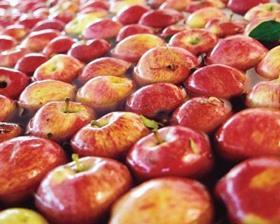
The cool spring has delayed the start of the 2016 Chilean apple harvest and will result in a shortage of larger sizes this season.
Early forecasts for 2016 suggest that export volumes are set to rise by 10 per cent compared to last year. However, an absence of larger sized fruit and low coloration in some varieties coupled with poor market conditions will pose significant challenges for exporters.
Manuel Alcaíno, president of fresh produce consultancy Decofrut, said although output would be up on 2015, production and export volumes would still fall short of initial expectations.
“Preliminary estimates peg the export crop at 670,300 tonnes, an increase of 10 per cent on 2015 but still lower than the figures achieved in 2012, 2013 and 2014,” Alcaíno said.
Inclement weather caused by El Niño caused widespread problems with pollination and fruitset last year, leading to a 24 per cent fall in exports compared to 2014. Shipments totalled 611,759 tonnes or 34.4m cartons.
“In terms of quality, the cold spring means there will be an abundance of medium and smaller sizes and an absence of larger fruit. However, since January, temperatures have been higher than average and this has had a negative effect colouration since the required range between day and night time temperatures has not occurred,” Alcaíno continued.
According to Decofrut, an increase in new acreage is expected to lead to a 17 per cent rise in Gala production to 339,600 tonnes. Volumes of red varieties, Granny Smith and Fuji, meanwhile, are expected to rise slightly compared to last year. The Red Delicious crop is pegged at 91,600 tonnes (+1 per cent), Granny Smith at 78,600 tonnes (+3 per cent) and Fuji at 53,000 tonnes (+2 per cent).
Pink Lady was one of the varieties most affected by the cold spring, and as a consequence output is projected to fall by 1 per cent to 72,000 tonnes.
Chile’s main export markets are the US, Europe, Latin America and the Middle East. Alcaíno said each would present its own challenges this season.
“The fact that oil prices have fallen from US$100 per barrel last year to US$25 today is bound to impact consumption and prices in the Middle East and suggests that it will be hard for Chilean exporters to achieve a profitable season there,” he noted. “The industry also faces a complicated situation in Latin America due to the devaluation of the Colombian, Brazilian and Ecuadorean currencies.”
However, Alcaíno predicted that Europe could still prove to be a good market for high quality fruit: “Although still high, stocks are lower than in previous years and problems with the condition of European apples means domestic prices are low. This suggests that fruit with good sizes and coloration could achieve high prices,” he said, adding that the same was true of the US market.
Alcaíno pointed out that the high degree of diversification of Chile’s export markets increased the chances of achieving good returns. “We mustn’t forget that there are markets for all types of fruit,” he said.



